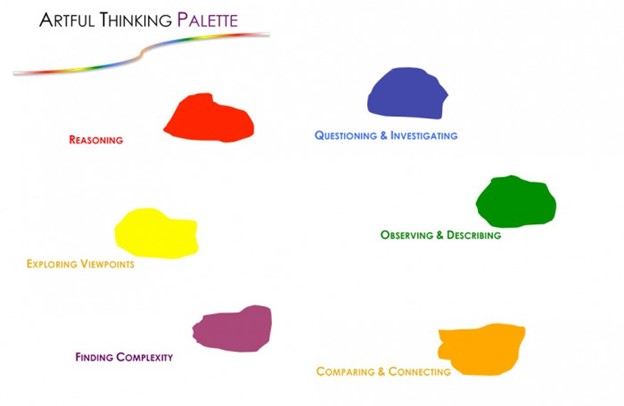Downloads
Artful Thinking Routines, designed by Project Zero at Harvard University, develop students’ critical thinking through the use of simple activities that guide them in responding to art. Visual art can be a springboard for developing thinking skills and habits that students can then apply across the curriculum. Artful Thinking Routines support several thinking dispositions – Questioning and Investigating, Observing and Describing, Comparing and Connecting, Finding Complexity, Exploring Viewpoints, and Reasoning.
We provide four graphic organizers, which can be used with any work of art, with unique prompts and questions that target specific thinking dispositions. The graphic organizers can be downloaded in PDF form at the link above and are useful in making students’ thinking visible to themselves, to peers, and to teachers. If students are still developing their writing skills, the worksheets can be adapted as a verbal activity or with student responses scribed by a teacher. The prompts and questions for each routine are included below.
Looking 5 x 2
Thinking dispositions this supports: Observing and Describing
- Look at the artwork for a full minute.
- On your own, list five descriptive words or phrases about any aspect of the artwork.
- Share something from your list with a partner or the group.
- Repeat steps 1 and 2. Try to add five new descriptive words or phrases to your list.
- Share a new observation with a partner or the group.
Creative Questions
Thinking dispositions this supports: Questioning and Investigating
- Brainstorm open-ended questions about the artwork using the questions stems provided or your own.
- Put a star next to the question you think would be most interesting to discuss.
- Share your question with a partner or the group.
3 Details/3 Feelings
Thinking dispositions this supports: Exploring Viewpoints, Reasoning
- Name one feeling this artwork suggests for you.
- What are three details you see that evoke this feeling?
- Choose a new detail that stands out to you to focus on.
- What are three feelings that detail could evoke?
- Now try on someone else’s feeling (from a partner or the group) – a feeling that wasn’t an initial response for you. Look at the work of art again through that lens – what is your experience viewing this work through someone else’s emotional response?
3-2-1 Bridge
Thinking dispositions this supports: Observing and Describing, Questioning and Investigating, Comparing and Connecting
- What are three observations or things you notice about this artwork?
- What are two questions that come to mind about this artwork?
- If this artwork (or part of it) were a metaphor for something, what might it represent?
- How might you see yourself reflected in this artwork? How might this artwork be a bridge to you, your feelings, and/or your experiences?

